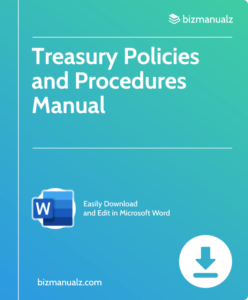What Should You Know About CFO Treasury Risk Management?

As a CFO, Treasury Risk Management has a crucial role in managing the financial health and stability of your organization. One crucial aspect of this is understanding and effectively managing treasury risk. This article will provide you with valuable insights and strategies to mitigate risks and protect your organization’s finances. Are you ready to take your treasury risk management skills to the next level? What should a CFO know about treasury risk management?
What Is Treasury Risk Management?

Treasury Policies and Procedures Manual | ABR260
Treasury risk management is the process of identifying, measuring, and mitigating potential risks that may affect a company’s treasury operations. It involves addressing various financial risks, including interest rate risk, foreign exchange risk, credit risk, and liquidity risk. By implementing effective risk management strategies, CFOs can protect the company’s financial assets and ensure its stability.
For instance, a CFO of a multinational corporation may utilize treasury risk management techniques to hedge against currency fluctuations and minimize their impact on the company’s cash flow and profitability. Understanding and implementing treasury risk management is essential for CFOs to safeguard the financial well-being of their organizations.
Real-life Example: A manufacturing company’s CFO diligently employed treasury risk management strategies to reduce exposure to interest rate fluctuations. By utilizing interest rate swaps and other hedging instruments, the company successfully locked in favorable interest rates on its long-term debt, resulting in millions of dollars in interest savings over time. This proactive approach enabled the company to allocate more resources towards growth initiatives and strengthen its financial position in the market.
With every financial decision you make, there is an element of risk. And as a CFO, it is your responsibility to ensure that your organization’s treasury risk is managed effectively. This article will equip you with the knowledge and tools to confidently navigate this important aspect of financial management. Are you ready to become a treasury risk management expert?
Why Is Treasury Risk Management Important for CFOs?
The importance of treasury risk management for CFOs cannot be overstated, as it allows them to effectively identify, assess, and mitigate risks associated with their organization’s treasury operations. This is crucial in protecting the company’s financial assets, ensuring liquidity, and strategically managing cash flows.
By carefully managing treasury risks, CFOs can minimize the impact of market fluctuations, changes in interest rates, foreign exchange risks, and credit risks. This not only allows them to make informed decisions, but also optimize capital allocation and enhance overall financial performance. Ultimately, treasury risk management empowers CFOs to safeguard the financial stability and success of their organizations.
What Are the Key Components of Treasury Risk Management?
As a Chief Financial Officer, understanding and effectively managing treasury risk is crucial for the financial health and stability of a company. This section will cover the key components of treasury risk management, including identifying and assessing risks, establishing risk management policies and procedures, implementing risk mitigation strategies, and monitoring and reporting risk management activities. By gaining an understanding of each component, CFOs can make informed decisions and mitigate potential risks in their organization’s treasury operations.
1. Identifying and Assessing Risks
Identifying and assessing risks is a crucial step in effective treasury risk management for CFOs. This process involves evaluating potential risks faced by the treasury department and their potential impact on the organization. To successfully manage these risks, CFOs should follow these steps:
- Conduct a comprehensive risk assessment to identify potential risks.
- Analyze the likelihood and potential impact of each identified risk.
- Quantify risks using appropriate risk measurement techniques.
- Prioritize risks based on their severity and likelihood.
- Develop risk mitigation strategies and contingency plans for high-priority risks.
- Regularly review and update risk assessments to account for changes in the business environment.
By diligently following these steps, CFOs can proactively manage treasury risks and safeguard the financial well-being of the organization.
2. Establishing Risk Management Policies and Procedures
Establishing risk management policies and procedures is a crucial aspect of treasury risk management for CFOs. Here are the key steps to follow:
- Identify and assess risks: Conduct a comprehensive analysis to identify potential risks that could impact the treasury department.
- Develop clear and concise policies: Establishing risk management policies is essential for effectively managing and mitigating potential risks.
- Implement risk mitigation strategies: Take necessary steps to minimize the impact of identified risks, such as diversifying investments or implementing hedging strategies.
- Monitor and report risk management activities: Regularly monitor risks and their effectiveness, and provide timely reports to stakeholders to ensure transparency.
By following these steps, CFOs can effectively establish risk management policies and procedures, ensuring the protection of the organization’s financial stability.
3. Implementing Risk Mitigation Strategies
Implementing risk mitigation strategies is a crucial aspect of treasury risk management for CFOs. To effectively mitigate risks, CFOs should follow a systematic approach:
- Identify Risks: Conduct a thorough assessment of potential risks in treasury operations.
- Analyze Risks: Evaluate the likelihood and potential impact of each identified risk.
- Develop Strategies: Create customized strategies to address and mitigate each identified risk.
- Implement Controls: Establish control measures and procedures to minimize the occurrence of risks.
- Monitor Effectiveness: Continuously monitor the effectiveness of implemented risk mitigation strategies.
- Update and Improve: Regularly review and update risk mitigation strategies based on changing circumstances and emerging risks.
By diligently following these risk mitigation strategies, CFOs can safeguard their organization’s financial stability and reputation.
4. Monitoring and Reporting Risk Management Activities
Monitoring and reporting risk management activities is a crucial responsibility for CFOs in treasury risk management. This involves a series of essential steps:
- Establishing clear metrics and key performance indicators to track risk management activities.
- Regularly monitoring and assessing the effectiveness of risk mitigation strategies.
- Producing accurate and timely reports on risk exposures, trends, and potential vulnerabilities.
- Communicating risk management findings and recommendations to key stakeholders, including senior management and the board of directors.
Fact: Accurate and timely monitoring and reporting of risk management activities can help CFOs identify potential risks early on and take proactive measures to mitigate them, safeguarding the financial health and reputation of the organization.
What Are the Types of Risks Faced by Treasury Departments?
As a Chief Financial Officer (CFO), it is crucial to have a comprehensive understanding of treasury risk management in order to effectively oversee the financial operations of a company. One aspect of this is understanding the various types of risks that a treasury department may face.
In this section, we will delve into the four main types of risks: market risk, credit risk, liquidity risk, and operational risk. By understanding these risks, a CFO can better strategize and mitigate potential financial challenges.
1. Market Risk
Market risk is a crucial concern for CFOs when managing treasury risk. To effectively handle market risk, CFOs should follow these steps:
- Identify potential market risks, such as fluctuations in interest rates or changes in currency exchange rates.
- Assess the impact of these risks on the organization’s financial position and performance.
- Establish policies and procedures to mitigate market risks, such as implementing hedging strategies or diversifying investments.
- Implement risk mitigation strategies by executing trades or entering into derivative contracts.
- Monitor and regularly review market risk exposures and the effectiveness of mitigation strategies.
By carefully managing market risk, CFOs can protect the organization from financial losses and ensure its long-term stability in a volatile market environment.
2. Credit Risk
Credit risk is a crucial aspect of treasury risk management for CFOs. It refers to the possibility of financial losses resulting from borrowers or counterparties failing to fulfill their payment obligations. To efficiently handle credit risk, CFOs must consider various factors.
Firstly, they should establish robust processes for assessing credit risk, including evaluating the creditworthiness of counterparties and setting credit limits. Secondly, they should implement risk mitigation strategies such as diversifying counterparties and utilizing credit derivatives. Lastly, continuous monitoring and reporting of credit risk activities is crucial to ensure prompt action. By effectively managing credit risk, CFOs can safeguard their organization’s financial stability and reputation.
3. Liquidity Risk
Liquidity risk, also known as 3. Liquidity Risk, refers to the potential for a company to face difficulty in meeting its short-term obligations due to a lack of cash or easily convertible assets. Effective management of liquidity risk is crucial for treasury departments. Here are the key steps to address 3. Liquidity Risk:
- Monitor cash flow: Regularly track cash inflows and outflows to identify potential liquidity gaps.
- Establish cash reserves: Maintain sufficient cash reserves to cover short-term obligations and unexpected expenses.
- Diversify funding sources: Explore different financing options to reduce reliance on a single source of funding.
- Create contingency plans: Develop strategies to address potential liquidity crises, such as accessing credit lines or renegotiating payment terms with suppliers.
- Optimize working capital: Efficiently manage accounts receivable, accounts payable, and inventory to improve cash flow.
By following these steps, treasury departments can mitigate 3. Liquidity Risk and ensure the smooth functioning of daily operations.
4. Operational Risk
Operational risk is a crucial aspect of managing treasury risk. It encompasses the potential for losses resulting from inadequate or failed internal processes, systems, or human factors. This can include errors in transaction processing, technology failures, and fraud.
To mitigate operational risk, CFOs can implement strong controls, conduct regular audits, and ensure staff training. Failure to effectively manage operational risk can result in financial losses, damage to reputation, and potential regulatory and legal issues.
In fact, there are numerous examples throughout history of companies that have suffered significant losses due to operational failures, such as the collapse of Barings Bank in 1995 due to unauthorized trading by a rogue trader.
How Can CFOs Ensure Effective Treasury Risk Management?
As a CFO, it is crucial to have a thorough understanding of treasury risk management in order to protect the financial stability of your organization. But how can CFOs ensure that their treasury risk management strategies are effective?
In this section, we will discuss three key ways that CFOs can optimize their treasury risk management approach. From collaborating with other departments to utilizing technology and data analytics, and staying informed and adaptable, we will explore the essential steps that CFOs can take to ensure the best possible outcomes for their organization.
1. Collaborating with Other Departments
Effective treasury risk management and maintaining an organization’s financial health requires collaborating with other departments.
- Establishing clear communication channels is crucial for fostering collaboration and sharing information.
- Involving relevant departments, such as finance, accounting, legal, and compliance, in the risk management process is essential.
- Coordinating with the procurement department is necessary to assess supplier risks and negotiate favorable terms.
- Working closely with the IT department ensures data security and the implementation of robust risk monitoring systems.
- Collaborating with the operations department helps identify and mitigate operational risks that may impact treasury activities.
- Engaging with the sales and marketing teams is important in understanding customer credit risks and developing appropriate credit policies.
2. Utilizing Technology and Data Analytics
Utilizing technology and data analytics is crucial for effective treasury risk management. Here are the steps to implement this approach:
- Implement treasury management systems (TMS) to automate processes, enhance data accuracy, and improve efficiency.
- Utilize data analytics tools to analyze large quantities of financial data, identify patterns, and detect potential risks.
- Leverage artificial intelligence and machine learning algorithms to predict market trends, optimize cash flow forecasting, and mitigate risks.
- Integrate real-time data feeds and APIs to ensure up-to-date information on market conditions and financial positions.
- Use advanced risk modeling and scenario analysis to assess potential impacts and develop risk mitigation strategies.
By embracing technology and data analytics, CFOs can enhance decision-making, proactively manage risks, and safeguard the financial stability of their organizations.
3. Staying Informed and Adapting to Changes
Staying informed and being able to adapt to changes are crucial for effectively managing treasury risk. Here are some steps to follow:
- Stay updated on industry trends, regulatory changes, and market conditions to stay informed.
- Keep an eye on emerging technologies and innovations that may impact treasury operations.
- Regularly review and assess risk management strategies to ensure they align with the ever-evolving risks.
- Engage in continuous learning and professional development to stay ahead of industry developments.
In addition, it is important to seek input from stakeholders and collaborate with other departments to gather diverse perspectives and insights. Embrace a proactive and agile approach to successfully navigate the dynamic landscape of treasury risk management.
What Are the Consequences of Poor Treasury Risk Management?
In the fast-paced world of finance, effective treasury risk management is crucial for any successful organization. In this section, we will discuss the potential consequences of poor treasury risk management and how it can affect a company.
From financial losses to damage to reputation and even regulatory and legal issues, we will examine the various risks that arise when treasury management is not given proper attention. Stay tuned to learn more about the importance of effective treasury risk management for businesses.
1. Financial Losses
Financial losses are a significant consequence of poor treasury risk management. In order to mitigate the potential for financial losses, CFOs should take the following steps:
- Identify and assess risks: Conduct a thorough analysis of potential risks to the organization’s treasury function.
- Establish risk management policies and procedures: Develop clear policies and procedures for managing and mitigating risks.
- Implement risk mitigation strategies: Take proactive steps to minimize the impact of identified risks.
- Monitor and report risk management activities: Regularly monitor the effectiveness of risk management measures and report on their progress.
By following these steps, CFOs can help protect their organizations from the financial losses associated with inadequate treasury risk management.
2. Damage to Reputation
Damage to reputation is a significant consequence of poor treasury risk management for CFOs. Mishandling risk can lead to negative publicity, loss of investor confidence, and damage to the company’s reputation.
For example, the 2008 financial crisis highlighted the importance of effective risk management. The collapse of Lehman Brothers resulted in severe reputational damage, ultimately leading to bankruptcy. This had a ripple effect, causing investors to lose trust, employees to lose jobs, and clients to suffer.
It took years for Lehman Brothers to rebuild its reputation after this true story, emphasizing the consequences that can arise from inadequate treasury risk management and the criticality of prioritizing it to maintain a company’s reputation.
3. Regulatory and Legal Issues
Effective treasury risk management involves understanding and navigating complex regulatory and legal issues. To ensure compliance and mitigate potential risks, CFOs should consider the following steps:
- Staying updated with regulatory requirements and changes related to regulatory and legal issues.
- Developing and implementing robust internal controls and policies to address these issues.
- Conducting regular audits and risk assessments to identify any non-compliance or legal vulnerabilities related to these issues.
- Engaging legal and compliance experts to provide guidance and advice on regulatory and legal issues.
- Establishing strong communication channels with regulatory bodies to address any concerns or seek clarification regarding these issues.
- Providing regular training and education to the treasury team regarding their legal and regulatory obligations related to these issues.
- Monitoring and reviewing internal processes to ensure ongoing compliance with these issues.
By proactively addressing regulatory and legal issues, CFOs can safeguard their organizations from potential penalties, reputational damage, and legal consequences.
CFO Treasury Risk Management
Frequently Asked Questions

What should a CFO know about Treasury Risk Management?
As a CFO, you should have a good understanding of treasury risk management to effectively manage your company’s financial risks and ensure its financial stability. This includes knowing the different types of risks, the strategies for managing them, and the tools and techniques used in treasury risk management.
What are the types of risks involved in Treasury Risk Management?
There are various types of risks that a CFO should be aware of in treasury risk management, including interest rate risk, credit risk, foreign exchange risk, liquidity risk, and operational risk. Each of these risks can have a significant impact on a company’s financial performance and should be carefully managed.
What are the strategies for managing Treasury Risks?
The strategies for managing treasury risks involve identifying and assessing the risks, developing risk management policies and procedures, implementing effective controls and mitigation techniques, and regularly monitoring and evaluating the risks. It also involves having a solid contingency plan in place to minimize the impact of any potential risks.
What tools and techniques are used in Treasury Risk Management?
Treasury risk management makes use of various tools and techniques, such as cash flow forecasting, interest rate swaps, currency options, credit default swaps, and hedging. These tools and techniques help CFOs to mitigate risks and better manage their company’s financial resources.
Why is Treasury Risk Management important for a CFO?
Treasury risk management is crucial for a CFO because it helps to ensure the financial stability of the company and minimize the impact of potential risks. By having a good understanding of treasury risk management, a CFO can make informed decisions and develop effective strategies to protect the company’s financial resources.
How can a CFO implement an effective Treasury Risk Management strategy?
To implement an effective treasury risk management strategy, a CFO should establish clear risk management policies and procedures, conduct regular risk assessments and evaluations, utilize appropriate tools and techniques, stay informed about the latest market trends and changes, and maintain open communication with stakeholders.















Leave a Reply